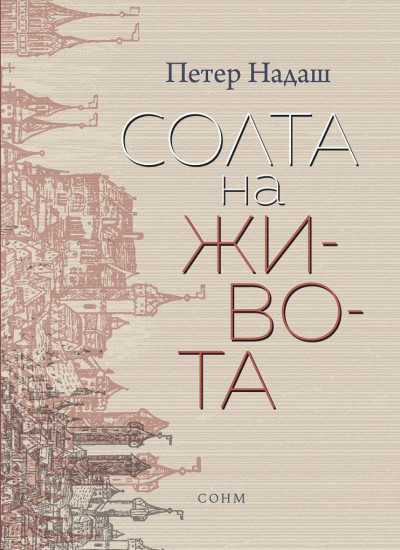The Salt of Life

The volume consists of twelve short units, signifying the months of the original publication on litera.hu: from a distance this could provoke associations with the Yearbook, but its brevity and reticence amongst the Nádas books are more striking. Péter Nádas, the author of gargantuan novels, at times writes sentences that are longer than this book: the seemingly riskfree escapades in the history of a “little southern German town” can therefore certainly be recommended as appetizers for future readers of Nádas.
Short it may be, but there is room for astonishingly many things in this book. Based on the title we might be expecting some kind of philosophical summary, the “gist” of the writer’s life experiences. The first twist is that salt is not meant first and foremost metaphorically, salt is indeed a material of life, a product in the little southern German town that is painted in the essays. So among other things, we learn about the procedures of salt distillation.
The meanings beyond the description – and the same goes for the entire volume – are not overemphasized, the text is not crammed and jammed with scholarly homilies, and yet intriguing observations keep popping up, offering delights for the readers who are familiar with the oeuvre, as they call to mind several earlier text encounters. The same applies to the meticulous description of the bells. The comprehensive inventory of the bells of the town is complemented not only by the portrayal of their practical functions, their roles in everyday life, the Biblical quotations on them are also woven into the narrative train of thought.
The clerical, religious, theological references make up the backbone of the reasoning anyway. The terminal point of the sketched historical curve is the reformation. As we read: “Quietly laboring interests lead to hazardous undertakings, and beyond lie the uplands of ideologies. On the landscape of history, the rivulets of self-interests join to form the great river of emancipation, carrying the reformation on its waves.” (38) The last two chapters tell the taleof Johannes Brenz, the town’s “preacher famous far and wide.” his meeting with Luther and his ending up in the town. The history lesson even shows a glimpse of the theological dispute on the subject of receiving the communion under one or both elements. This closing is, however, arbitrary. The fable-like conclusion shows that the writer has not run out of topics, merely out of time.

Péter Nádas (1942 - ) is one of the most prominent figures of contemporary Hungarian literature and a representative of the 1970s paradigm shift in Hungarian fiction, Péter Nádas always deals with the most urgent issues of the world today: the quest for the self, the loss and retrieval of memory, the relationship between the individual and power.
His works have been translated into and are known in several languages, including Russian.
His works published in Russian in the early 21st century include the novels The End of a Family Story (2003), translated by Elena Malykhina, A Book of Memories (2014), and Own Death (2010); the volume of essays A szabadság tréningjei [Trainings in Freedom] (2004), translated by Vâčeslav Sereda; as well as an essay and the poem “A Sedimental Glossary” (2017), published in my translation. As I have been writing about Hungarian plays and translating them to Russian for years (nine plays and dozens of screenplays so far), I have always felt that Nádas’s dramas, and especially the Trilogy, need to be translated into Russian to address a lacuna, and because all three have proven to excellent works of the theater, as exemplified by their success both in Hungary and abroad.